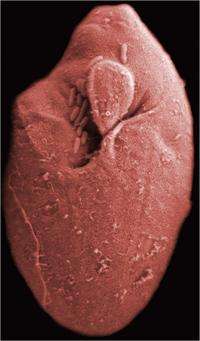Single-cell marine predator's unique survival mechanisms revealed

(PhysOrg.com) -- University of British Columbia researchers have uncovered the unique survival mechanisms of a marine organism that may be tiny, but in some ways has surpassed sharks in its predatory efficiency.
Published today in the journal Nature Communications, the research team's portrait of the microscopic dinoflagellate Oxyrrhis marina reveals a predator so efficient that it has even acquired a gene from its prey.
"It's an interesting case of Lateral Gene Transfer, or the movement of genes between distantly related species," says Patrick Keeling, a UBC botany professor and one of the study's authors.
"Our study shows that Oxyrrhis marina has picked up a gene commonly used by marine bacteria for photosynthesis. Oxyrrhis probably got this gene by eating the bacteria, but the really interesting part is that the gene produces a protein called rhodopsin, which is a photoreceptor that can make energy from light."
Humans possess similar proteins in our eyes, called opsin, that enable vision in low-light conditions, but cannot produce energy.
"It is very much a case of 'you are what you eat,' because Oxyrrhis marina has so much rhodopsin in its system that it has assumed the protein's signature pink colour," says Keeling. "Our hypothesis is that it is using the rhodopsin to harvest energy from light – as bacteria often do – but we think that it also uses the energy to help digest its prey, some of which were the original supplier of the gene. It is a really neat mix of metabolic strategies."
Oxyrrhis marina is part of a family of marine plankton that also includes the organisms responsible for harmful red tides. It is common in shallow waters such as tide pools around the world, including along the British Columbia coast. It has evolved extreme survival mechanisms, including the ones described in the UBC study. Oxyrrhis marina can cannibalize its own species when no other prey is available.
"It definitely deserves to be called a predator – it can feed on cells almost as big as itself," says Keeling, director of the Centre for Microbial Diversity and Evolution and a member of Beaty Biodiversity Research Centre at UBC. "It is also extremely tough to kill it."
Provided by University of British Columbia

















